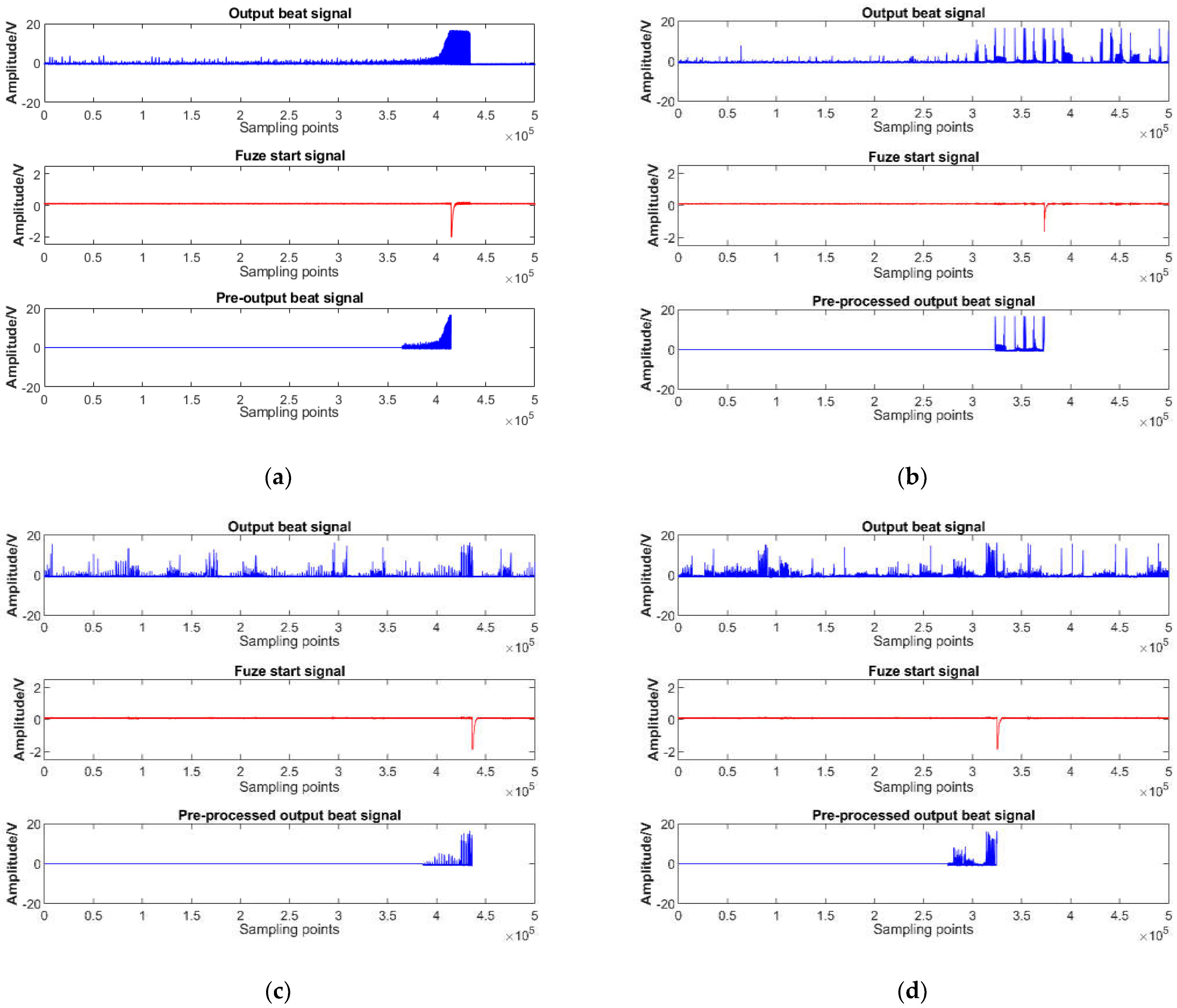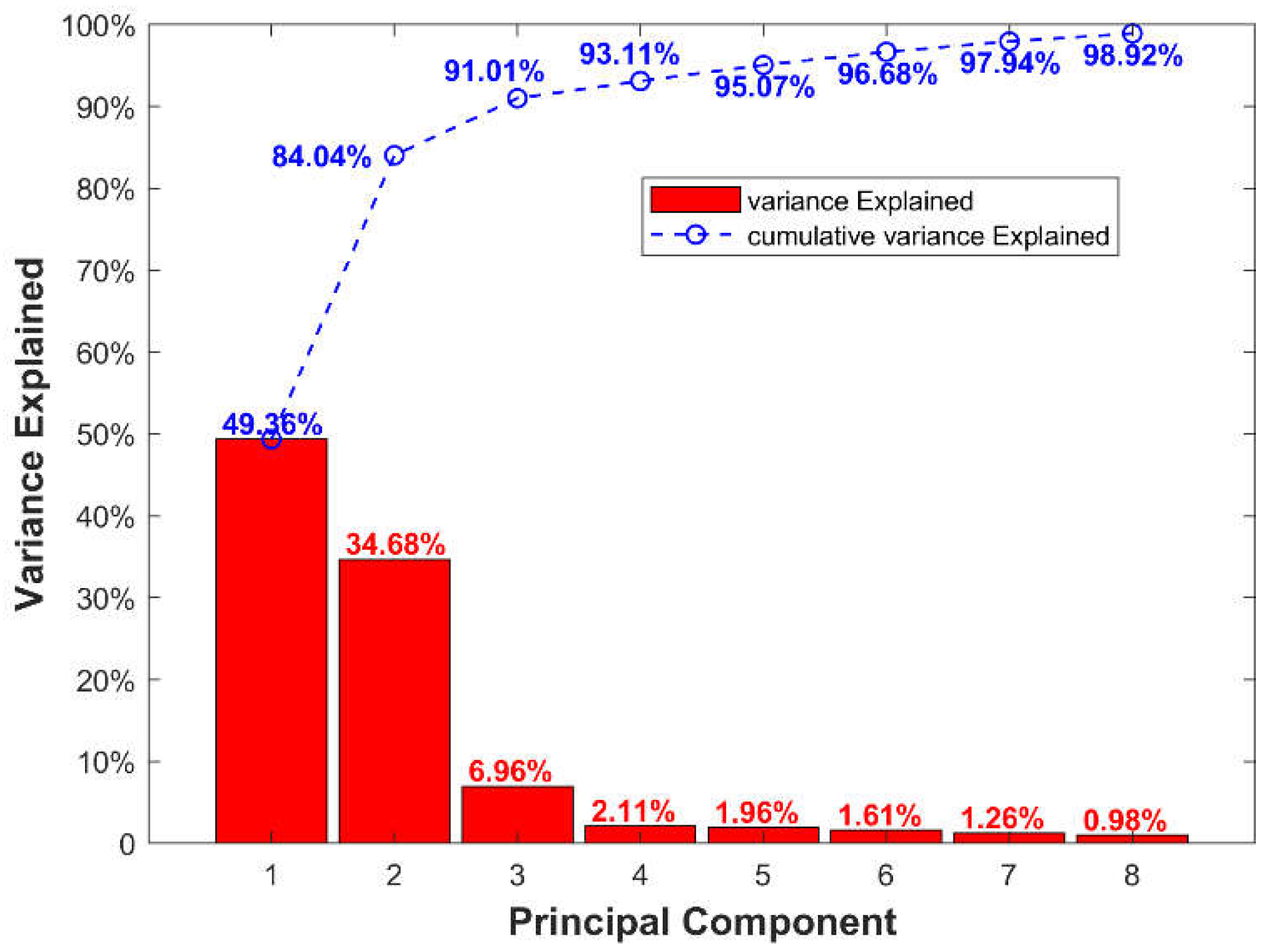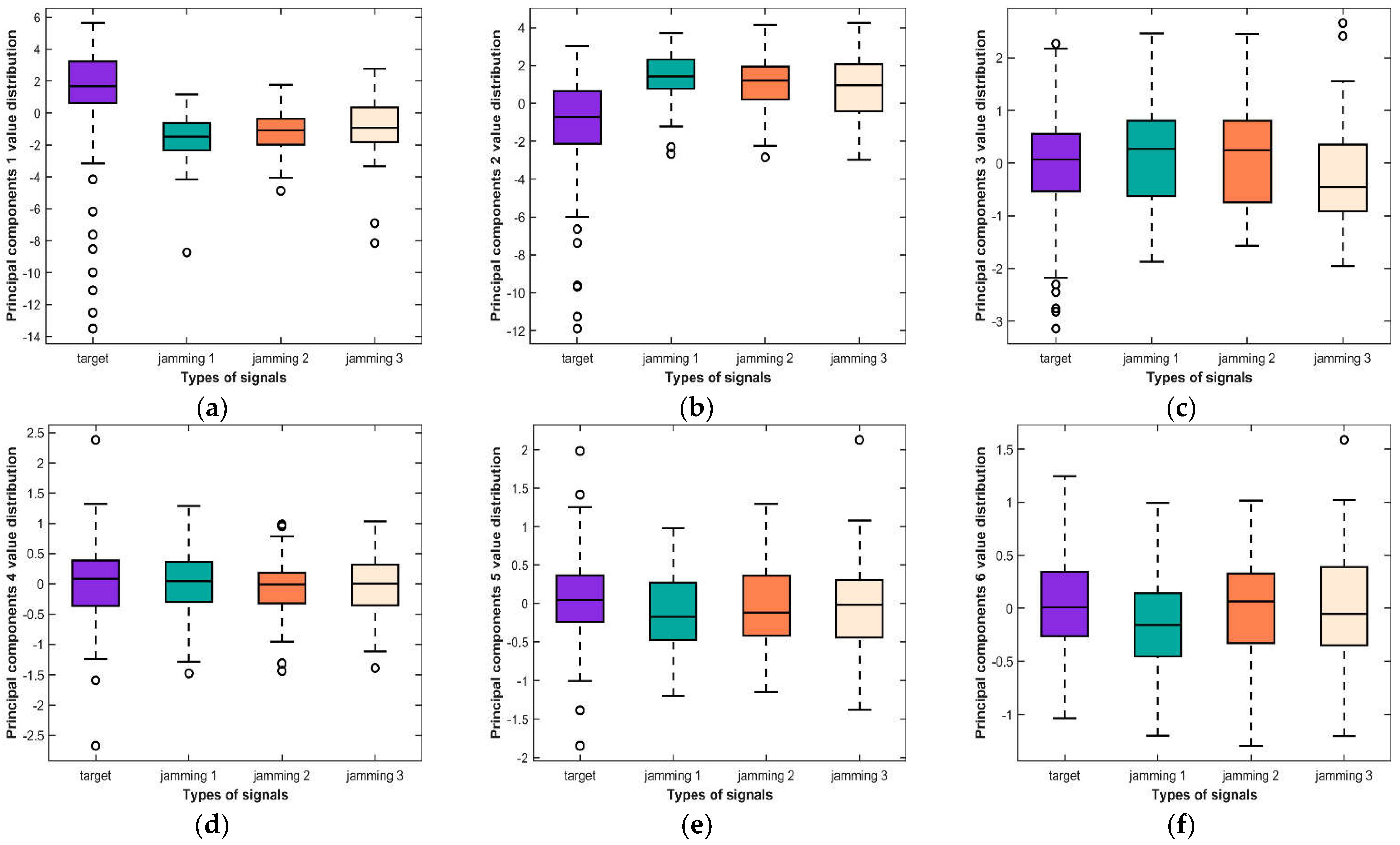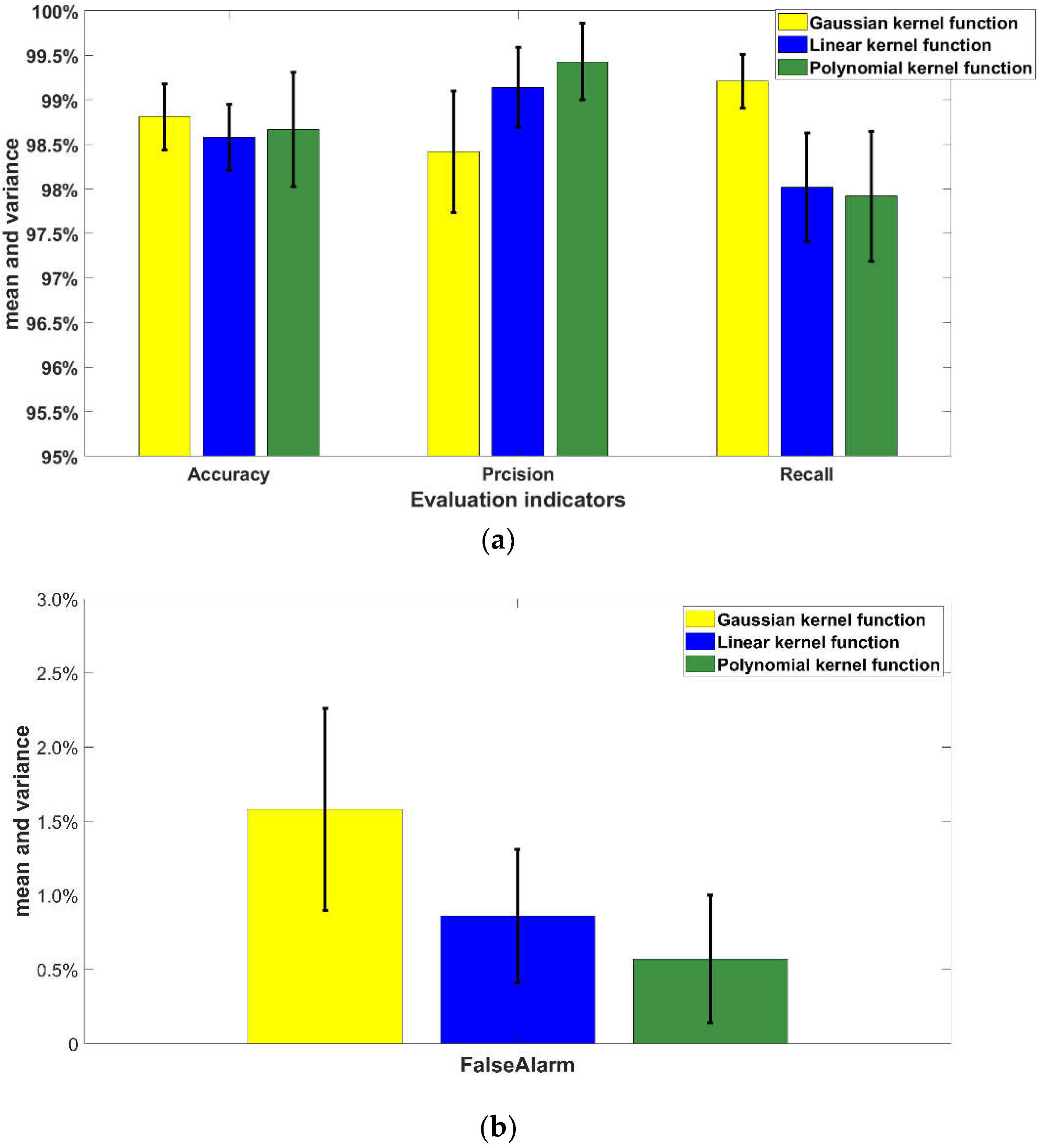Research on Anti-Frequency Sweeping Jamming Method for Frequency Modulation Continuous Wave Radio Fuze Based on Wavelet Packet Transform Features
Abstract
:1. Introduction
2. Experimental Setup and Data Collection
2.1. Experimental Scene Setting and Parameter Setting
2.2. Experimental Data Collection
3. Wavelet Packet Transform-Based Feature Extraction
3.1. Basic Theory of Wavelet Packet Transform
3.2. Signal Pre-Processing
3.3. Signal Features Extraction
3.4. Signal Features Dimensionality Reduction
4. Target and Frequency Sweeping Jamming Classification Experiment
4.1. Pre-Experimental Data Preparation
4.2. Experimental Evaluation Indicators
4.3. Experimental Results
5. Conclusions
Author Contributions
Funding
Informed Consent Statement
Conflicts of Interest
References
- Choi, J.H.; Lee, J.M.; Jung, M.S.; An, J.Y.; Kim, K.L. FMCW transceiver of short-range proximity sensor in sea clutter. Microw. Opt. Technol. Lett. 2017, 59, 334–337. [Google Scholar] [CrossRef]
- Dai, J.; Hao, X.H.; Liu, Q.; Yan, X.P.; Li, P. Repeater jamming suppression method for pulse Doppler fuze based on identity recognition and chaotic encryption. Def. Technol. 2021, 17, 1002–1012. [Google Scholar] [CrossRef]
- Fericean, S.; Dorneich, A.; Droxler, R.; Krater, D. Development of a microwave proximity sensor for industrial applications. IEEE Sens. J. 2009, 9, 870–876. [Google Scholar] [CrossRef]
- Li, Z.; Yan, X.P.; Li, P.; Hao, X.H.; Wang, J.T. Jamming mechanism of frequency sweep jamming to FM Doppler fuze. Acta Armament. 2017, 38, 1716–1722. [Google Scholar]
- Caddemi, A.; Cardillo, E. A low-cost smart microwave radar for short-range measurements. In Proceedings of the International Conference on Applications in Electronics Pervading Industry, Environment and Society, Rome, Italy, 21–22 September 2017. [Google Scholar]
- Choi, J.H.; Jung, M.S.; Yeom, K.W. A design and assessment of a direction finding proximity fuze sensor. IEEE Sens. J. 2013, 13, 3079–3089. [Google Scholar] [CrossRef]
- Yue, K.; Hao, X.H.; Li, P. An LFMCW detector with new structure and FRFT based differential distance estimation method. SpringerPlus 2016, 5, 922. [Google Scholar] [CrossRef]
- Chen, Q.L.; Hao, X.H.; Yan, X.P.; Qiao, C.X.; Wang, X.W. Anti sweep jamming method of hybrid modulation fuze based on harmonic coefficient amplitude averaging. Beijing Univ. Aeronaut. Astronaut. 2020, 46, 1317–1324. [Google Scholar]
- Qiao, C.X.; Hao, X.H.; Chen, Q.L.; Kong, Z.J.; Wang, X.W. Anti-DRFM-jamming method based on averaging of rangeside lobes for hybrid modulation radio fuze. Acta Armament. 2020, 41, 641–648. [Google Scholar]
- Akhtar, J. Orthogonal block coded ECCM schemes against repeat radar jammers. IEEE Trans. Aerosp. Electron. Syst. 2009, 45, 1218–1226. [Google Scholar] [CrossRef]
- Dai, J.; Hao, X.H.; Li, Z.; Li, P.; Yan, X.P. Adaptive target and jamming recognition for the pulse doppler radar fuze based on a time-frequency joint feature and an online-updated naïve bayesian classifier with minimal risk. Def. Technol. 2022, 18, 457–466. [Google Scholar] [CrossRef]
- Huang, Y.; Hao, X.H.; Kong, Z.J.; Zhang, B. Recognition of target and jamming signal for FM fuze based on entropy features. Acta Armament. 2017, 38, 254–260. [Google Scholar]
- Greco, M.; Gini, F.; Farina, A. Radar detection and classification of jamming signals belonging to a cone class. IEEE Trans. Signal Process. 2008, 56, 1984–1993. [Google Scholar] [CrossRef]
- Zhu, Y.Y.; Zhang, S.N.; Zhao, H.C.; Chen, S. Suppression of noise amplitude modulation interference in triangle frequency modulation detector based on FrFt. IEEE Sens. J. 2021, 21, 16107–16117. [Google Scholar] [CrossRef]
- Cardillo, E.; Caddemi, A. A novel approach for crosstalk minimisation in frequency modulated continuous wave radars. Electron. Lett. 2017, 53, 1379–1381. [Google Scholar] [CrossRef]
- Stove, A.; Baker, C. Radio-frequency interference to automotive radar sensors. IET Radar Sonar Nav. 2018, 12, 1154–1164. [Google Scholar] [CrossRef]
- Liu, W.Q.; Zhang, R.; Ling, Y.; Tang, H.P.; She, R.B.; Wei, G.L.; Gong, X.J.; Lu, Y.F. Automatic recognition of breast invasive ductal carcinoma based on terahertz spectroscopy with wavelet packet transform and machine learning. Biomed. Opt. Express. 2020, 11, 971–981. [Google Scholar] [CrossRef]
- Li, T.Y.; Zhou, M. ECG classification using wavelet packet entropy and random forests. Entropy 2016, 18, 285. [Google Scholar] [CrossRef]
- Rosso, O.A.; Blanco, S.; Yordanova, J.; Kolev, V.; Figliola, A.; Schurmann, M.; Basar, E. Wavelet entropy: A new tool for analysis of short duration brain electrical signals. J. Neurosci. Methods 2001, 105, 65–75. [Google Scholar] [CrossRef]
- Jin, Y.; Shan, C.Z.; Wu, Y.; Xia, Y.M.; Zhang, Y.T.; Zeng, L. Fault diagnosis of hydraulic seal wear and internal leakage using Wavelets and wavelet neural network. IEEE Trans. Instrum. Meas. 2019, 68, 1026–1034. [Google Scholar] [CrossRef]
- Liu, C.C.; Zhuo, F.; Wang, F. Fault diagnosis of communication failure using wavelet transform and wavelet neural network in HVDC transmission system. IEEE Trans. Instrum. Meas. 2021, 70, 1–8. [Google Scholar]
- Guo, M.F.; Zeng, X.D.; Chen, D.Y.; Yang, N.C. Deep-learning-based earth fault detection using continuous wavelet transform and convolutional neural network in resonant grounding distribution system. IEEE Sens. J. 2018, 18, 1291–1300. [Google Scholar] [CrossRef]
- Lei, L.; She, K. Identity vector extraction by perceptual wavelet packet entropy and convolutional neural network for voice authentication. Entropy 2018, 20, 600. [Google Scholar] [CrossRef] [PubMed]
- Daqrouq, K.; Azzawi, K.A. Acerage framing linear prediction coding with wavelet transform for text-independent speaker identification system. Comput. Electr. Eng. 2012, 38, 1467–1479. [Google Scholar] [CrossRef]
- Hidayat, S.; Tajuddin, M.; Yusuf, S.A.A.; Qudsi, J.; Jaya, N.N. Wavelet detail coefficient as a novel wavelet-mfcc features in text-dependent speaker recognition system. IIUM Eng. J. 2022, 23, 68–81. [Google Scholar] [CrossRef]
- Daamouche, A.; Hamami, L.; Alajlan, N.; Melgani, F. A wavelet optimization approach for ECG signal classification. Biomed. Signal. Proces. 2012, 7, 342–349. [Google Scholar] [CrossRef]
- Gubbi, J.; Khandoker, A.; Palaniswami, M. Classification of sleep apnea types using wavelet packet analysis of short-term ECG signals. J. Clin. Monit. Comput. 2012, 26, 1–11. [Google Scholar] [CrossRef]
- Mallat, S.G. A theory for multiresolution signal decomposition: The wavelet representation. IEEE Tran. Pattern. Anal. 1989, 11, 674–693. [Google Scholar] [CrossRef]
- Manish, K.; Satish, K.; Bhargab, D. Moving ground target detection with seismic signal using smooth pseudo wigner-ville distribution. IEEE Trans. Instrum. Meas. 2020, 69, 3896–3906. [Google Scholar]
- Manish, K.; Satish, K.; Bhargab, D. Seismic signal analysis using empirical wavelet transform for moving ground target detection and classification. IEEE Sens. J. 2020, 20, 7886–7895. [Google Scholar]
- Zhong, Y.; Eryk, D.; Yang, Y.; Zhu, X.; Zhou, Z.; Jiang, T. Internet of Mission-Critical Things: Human and Animal Classification—A Device-Free Sensing Approach. IEEE Internet Things 2018, 5, 3369–3377. [Google Scholar] [CrossRef]
- Xin, J.; Soumalya, S.; Asok, R.; Shalabh, G.; Thyagaraju, D. Target detection and classification using seismic and PIR sensors. IEEE Sens. J. 2012, 12, 1709–1718. [Google Scholar]









| Type of Parameter | Parameter Values |
|---|---|
| FMCW fuze centre frequency () | |
| FMCW fuze modulation bandwidth () | |
| Jammer distance () | |
| Target distance () | |
| Jamming signal frequency sweeping bandwidth () | * |
| Wavelet Packet Node | p-Value |
|---|---|
| (0,0) | |
| (1,0) | |
| (1,1) | |
| (2,0) | |
| (2,1) | |
| (2,2) | |
| (2,3) | |
| (3,0) | |
| (3,1) | |
| (3,2) | |
| (3,3) | |
| (3,4) | |
| (3,5) | |
| (3,6) | |
| (3,7) |
| Classified Type of Samples | Targets | Jamming Signals |
|---|---|---|
| Actual Type of Samples | ||
| Targets | TP | FP |
| Jamming signals | FN | TN |
| SVM Kernel Function | Evaluation Indicators | |||
|---|---|---|---|---|
| Gaussian | 98.81% ± 0.0037 | 98.42% ± 0.0068 | 99.21% ± 0.0030 | 1.58% ± 0.0068 |
| Linear | 98.58 ± 0.0037 | 99.14% ± 0.0045 | 98.02% ± 0.0061 | 0.86% ± 0.0045 |
| Polynomial | 98.67% ± 0.0064 | 99.43% ± 0.0043 | 97.92% ± 0.0073 | 0.57% ± 0.0043 |
Publisher’s Note: MDPI stays neutral with regard to jurisdictional claims in published maps and institutional affiliations. |
© 2022 by the authors. Licensee MDPI, Basel, Switzerland. This article is an open access article distributed under the terms and conditions of the Creative Commons Attribution (CC BY) license (https://creativecommons.org/licenses/by/4.0/).
Share and Cite
Liu, B.; Hao, X. Research on Anti-Frequency Sweeping Jamming Method for Frequency Modulation Continuous Wave Radio Fuze Based on Wavelet Packet Transform Features. Appl. Sci. 2022, 12, 8713. https://doi.org/10.3390/app12178713
Liu B, Hao X. Research on Anti-Frequency Sweeping Jamming Method for Frequency Modulation Continuous Wave Radio Fuze Based on Wavelet Packet Transform Features. Applied Sciences. 2022; 12(17):8713. https://doi.org/10.3390/app12178713
Chicago/Turabian StyleLiu, Bing, and Xinhong Hao. 2022. "Research on Anti-Frequency Sweeping Jamming Method for Frequency Modulation Continuous Wave Radio Fuze Based on Wavelet Packet Transform Features" Applied Sciences 12, no. 17: 8713. https://doi.org/10.3390/app12178713





